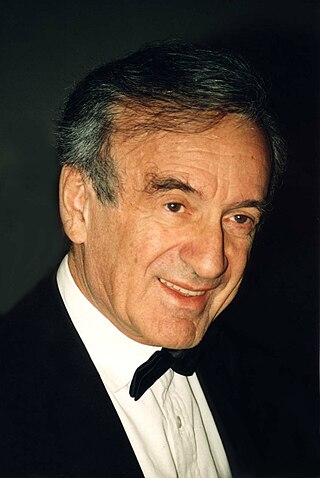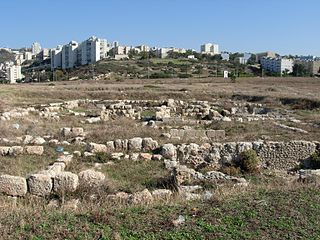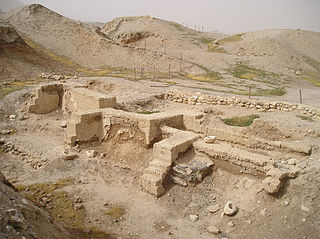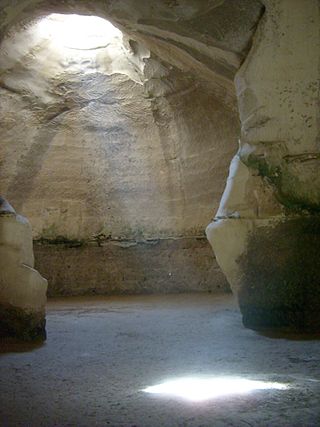Related Research Articles

Elie Wiesel was a Romanian-born American writer, professor, political activist, Nobel laureate, and Holocaust survivor. He authored 57 books, written mostly in French and English, including Night, a work based on his experiences as a Jewish prisoner in the Auschwitz and Buchenwald concentration camps.

Antipatris was a city built during the first century BC by Herod the Great, who named it in honour of his father, Antipater. The site, now a national park in central Israel, was inhabited from the Chalcolithic Period to the late Roman Period. The remains of Antipatris are known today as Tel Afek, although formerly as Kŭlat Râs el 'Ain. It has been identified as either the tower of Aphek mentioned by Josephus, or the biblical Aphek, best known from the story of the Battle of Aphek. During the Crusader Period the site was known as Surdi fontes, "Silent springs". The Ottoman fortress known as Binar Bashi or Ras al-Ayn was built there in the 16th century.

Beit She'an, also Beth-shean, formerly Beisan, is a town in the Northern District of Israel. The town lies at the Beit She'an Valley about 120 m below sea level.

Yavne or Yavneh is a city in the Central District of Israel. In many English translations of the Bible, it is known as Jabneh.

Apollonia, known in the Early Islamic period as Arsuf and in the Crusader Kingdom of Jerusalem as Arsur, was an ancient city on the Mediterranean coast of what is today Israel. In Israeli archaeology it is known as Tel Arshaf. Founded by the Phoenicians during the Persian period in the late sixth century BCE, it was inhabited continuously until the Crusader period, through the Hellenistic, Roman, and Byzantine periods, during the latter being renamed to Sozusa. It was situated on a sandy area ending towards the sea with a cliff, about 34 kilometres (21 mi) south of Caesarea.

Tel Dor or Tell el-Burj, also Khirbet el-Burj in Arabic, is an archaeological site located on the Israeli coastal plain of the Mediterranean Sea next to modern moshav Dor, about 30 kilometers (19 mi) south of Haifa, and 2.5 kilometers (1.6 mi) west of Hadera. Lying on a small headland at the north side of a protected inlet, it is identified with D-jr of Egyptian sources, Biblical Dor, and with Dor/Dora of Greek and Roman sources.

Tel Shikmona, or Tell es-Samak, also spelt Sycamine, is an ancient Phoenician tell (mound) situated near the sea coast in the modern city of Haifa, Israel, just south of the Israeli National Institute of Oceanography. It has been called a "forgotten Phoenician site". Nowadays researchers identify Tell es-Smak with Porphyreon (south).

Gamla, alt. sp. Gamala was an ancient Jewish city on the Golan Heights. It is believed to have been founded as a Seleucid fort during the Syrian Wars which was turned into a city under Hasmonean rule in 81 BCE. During the Great Revolt, it became an important stronghold for rebels and because of this Gamla is a symbol for the modern state of Israel and an important historical and archaeological site. It lies within the current Gamla nature reserve and is a prominent tourist attraction.

Kedesh was an ancient Canaanite and later Israelite settlement in Upper Galilee, mentioned few times in the Hebrew Bible. Its remains are located in Tel Kedesh, 3 km northeast of the modern Kibbutz Malkiya in Israel on the Israeli-Lebanese border.

The Israel Exploration Society (IES), originally the Jewish Palestine Exploration Society, is a society devoted to historical, geographical and archaeological research of the Land of Israel. The society was founded in 1914 with the object of studying the History and Civilization of Palestine and of disseminating its knowledge.

Tel Maresha is the tell of the biblical Iron Age city of Maresha, and of the subsequent, post-586 BCE Idumean city known by its Hellenised name Marisa, Arabised as Marissa (ماريسا). The tell is situated in Israel's Shephelah region, i.e. in the foothills of the Judaean Mountains, about 2 kilometres (1.2 mi) southeast of Beit Gubrin. It was first excavated in 1898-1900 by the British archaeologists Bliss and Macalister on behalf of the Palestine Exploration Fund and again after 1989 by Israeli archaeologist Amos Kloner on behalf of the Israel Antiquities Authority. Most of the artifacts of the British excavation are to be found today in the Istanbul Archaeology Museums.

Khirbet Kerak or Beth Yerah is a tell located on the southern shore of the Sea of Galilee in modern-day Israel. The tell spans an area of over 50 acres—one of the largest in the Levant—and contains remains dating from the Early Bronze Age and from the Persian period through to the Early Islamic period.

Levantine archaeology is the archaeological study of the Levant. It is also known as Syro-Palestinian archaeology or Palestinian archaeology. Besides its importance to the discipline of Biblical archaeology, the Levant is highly important when forming an understanding of the history of the earliest peoples of the Stone Age.

Beit Guvrin-Maresha National Park is a national park in central Israel, containing a large network of caves recognized by UNESCO as a World Heritage Site. The national park includes the remains of the historical towns of Maresha, one of the important towns of Judah during the First Temple Period, and Bayt Jibrin, a depopulated Palestinian town known as Eleutheropolis in the Roman era. However, Maresha and Bayt Jibrin are not part of the UNESCO site, which covers only the cave network.

Gabriel (Gaby) Mazor is an Israeli archaeologist working for the Israel Antiquities Authority. Mazor is the director and senior researcher of the Bet She'an Archaeological Project. He is the co-author of "NYSA-Scythopolis: The Caesareum and the Odeum" and has taught in Macalester College and the University of Rochester as a visiting professor. Mazor is also a project consultant on the Horbat ‘Omrit project.

Tel Anafa is an archaeological site and nature reserve in the Upper Galilee, Israel.
Seymour Gitin is an American archaeologist specializing in ancient Israel, known for his excavations at Tel Miqne-Ekron. He was the director of the Albright Institute of Archaeological Research (AIAR) in Jerusalem from 1980 to 2014.

Yoram Tsafrir was an Israeli archaeologist. His research has included the Byzantine influence on ancient synagogues, demography of Palestine in the Byzantine period, mosaics at Horvat Berachot, excavations at Beit She'an, and excavations at Rehoboth. A Professor Emeritus of the Institute of Archaeology at the Hebrew University of Jerusalem, he was a member of the Israel Academy of Sciences and Humanities.

Oded Lipschits is an Israeli professor in the Department of Archaeology and Ancient Near East Studies at Tel Aviv University. In 1997 he earned his Ph.D. in Jewish History under the supervision of Nadav Na'aman. He has since become a Senior Lecturer and Full Professor at Tel Aviv University and served as the Director of the Tel Aviv Institute of Archaeology since 2011. Lipschits is an incumbent of the Austria Chair of the Archeology of the Land of Israel in the Biblical Period and is the Head and founder of the Ancient Israel Studies Masters program in the Department of Archaeology and Ancient Near East Studies.
References
- 1 2 "Andrea M. Berlin". www.bu.edu. Retrieved 2017-03-12.
- ↑ "Andrea Berlin » Elie Wiesel Center for Jewish Studies - Blog Archive - Boston University". www.bu.edu. Retrieved 2017-03-12.
- ↑ "The Levantine Ceramics Project". www.levantineceramics.org. Retrieved 2017-03-12.